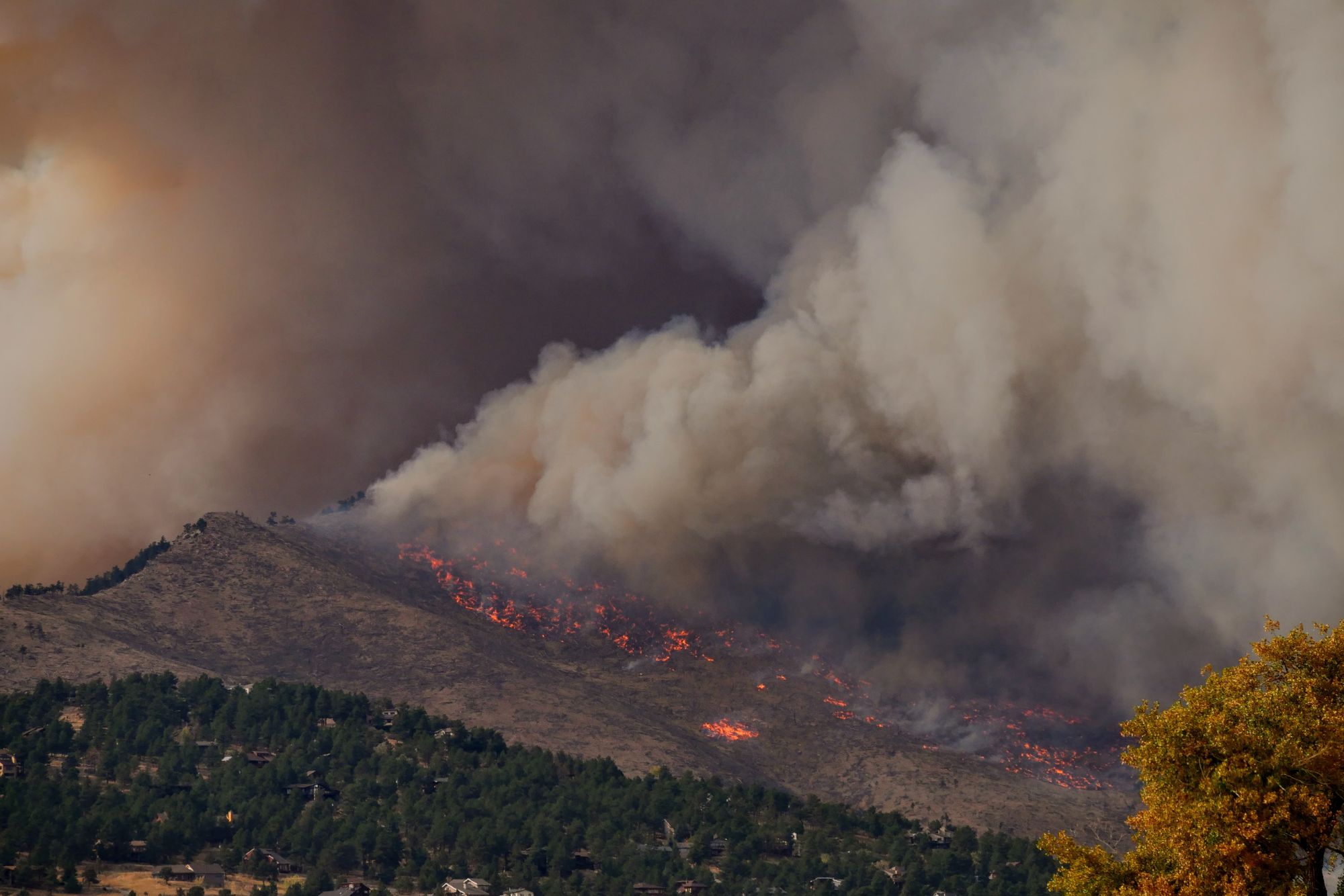On December 30, 2021, as the Marshall Fire tore through Louisville, Colorado, 25-year-old Mia Keller, an elite amateur marathoner and triathlete, was dog sitting for a family friend less than ten miles southeast from her apartment in Boulder.
Suddenly, the weather changed dramatically. "There were insane winds that day," Keller said. "The leaves were blowing off the trees." Soon, the house filled with smoke, and after a touch and go phone call with the homeowners just before the phone lines went down, Keller fled the house with the dog, five minutes before she received a mandatory evacuation notice. The house burned to the ground.
The Marshall Fire started just outside Boulder, Colorado, a city that is home base for world-class runners and endurance athletes because of its ideal training topography and altitude benefits. For many athletes like Keller, the fire upended their training and lives. Smoke kept them from training outside; fire decimated running trails; ongoing trauma left many unable to train consistently. More than a year after the fire, many athletes still experience the impacts of the most destructive fire in Colorado's history.
Most high-altitude running locations are arid and forested, making them prime real estate for wildfires. And as climate change accelerates, fires like this one will grow in frequency and magnitude, forcing many elite athletes to question whether it is safe and sustainable for them to train in the Western United States.
Keller's apartment in Boulder was untouched by the fire, but she lost $5,000 worth of biking gear when she evacuated the house where she was dog sitting. Her insurance recouped the cost of the equipment, but Keller, who was training for the Ironman World Championships, still experienced training disruptions.
The Marshall Fire burned nearly 10 square miles, destroying many running routes, including the popular Davidson Mesa trail, where Keller and other athletes used to train, and which remained closed for months following the fire.
Keller tried to run workouts on Marshall Road, which cut through the burn zone, but found it too upsetting to pass the charred ruins of houses lining both sides of the road. "For my own anxiety, I just stopped running there," she said.
In addition to losing gear and running routes, immediately following the fire, athletes had to contend with poor air quality. When the Marshall Fire razed her community, Sri Lankan record holder Hiruni Wijayaratne was training for a half marathon six weeks later. Wijayaratne's training would normally involve crossing through parts of the burn zone, but her training in Nepal two years earlier exposed her to poor air quality. Today, she is cautious about breathing polluted air.
"I think I'm still suffering from it," Wijayaratne said of her time training in Nepal. In the wake of the Marshall fire, Wijayaratne opted to train on a treadmill and even traveled to Arizona to run instead of venturing outside in Boulder where she suffers from acute effects of poor air quality.
"I'm constantly sneezing, my eyes are tearing, and then anytime I do anything that's harder than an easy run, I feel this horrible burn in my throat," said Wijayaratne.
Wildfire smoke contains high concentrations of gasses and particulate matter, explained Ana Rappold, EPA scientist who studies smoke and health during wildfire events. Wildfire smoke "definitely increases the health risks associated with respiratory outcomes," said Rappold. Respiratory health is a significant concern for endurance athletes who train outside and breathe a high volume of air.
But even among world class athletes, treadmills can be hard to find. Maddie Alm, a 30-year-old elite runner who trains with the Olympic-level Bosshard group, had to share two treadmills among ten runners in her Boulder-based training cohort. The athletes took turns training on the treadmills while their coach set up an air quality monitor to make sure that any smoke that entered the gym through vents and windows remained at a safe level for training.
Alm is based in Boulder but coaches cross country and track at Monarch High School, in Louisville, Colorado, where the fire burned over half of the 1,084 homes destroyed in the fire. Alm, a dietitian who manages her own practice on top of her own intense distance training, traveled back and forth between Louisville and Boulder organizing clothing and food drives for the high school students who lost their homes. "[My coach] modified my training because I wasn't getting much sleep," said Alm. "Coordinating the relief efforts took a big toll on me mentally and physically."
Alm ran her debut half marathon just two weeks after the fire and was disappointed in her race result. Her track season that spring was also lackluster. She was chronically tired and suffered from low iron. Alm's coach pointed out that her performance began to suffer right after the fire.
Many other athletes also experienced significant training disruptions as a result of psychological and physical impacts of the fire. Laura Thweatt, a marathoner who has lived and trained in Boulder for more than a decade, stopped training almost entirely. She tried to run again at the end of January. "I showed up to a workout and I just started crying," Thweatt said. She then dialed back her training in order to process the trauma of the event.
"I definitely think the long-term effects of everything that happened a year ago out here are something that I still carry," Thweatt said at the anniversary of the fire.
According to Emily Saul, sports psychologist and licensed mental health counselor, it's not just the fire itself that can affect athletes, but the lingering threats and reminders even once the initial danger has passed.
A disaster such as wildfire activates the sympathetic nervous system, which floods the body with hormones and results in a fight, flight, or freeze response, preparing the body to address the threat without much conscious thought. If a person can escape the fire or take some action to remove herself from danger, then the parasympathetic nervous system kicks in, calming the body down and returning it to baseline, said Saul.
But if the dangerous situation is ongoing—if the winds change and the fire gets closer, or if housing and property are destroyed and survivors must address their basic needs, or even if there are constant reminders of the fire's destruction—the nervous system can remain activated.
Saul describes the nervous system like a car, where the sympathetic nervous system is the accelerator, and the parasympathetic nervous system acts as the brake. When the situation is intense and prolonged, and especially when resources and support are limited, "then people tend to feel like they are in this car with a revving engine that has no brake," Saul said. Both the sympathetic and parasympathetic systems get tired, and people lose the ability to calm themselves down.
"That's a pretty non optimal situation for people to then be athletes," said Saul. Not only were the athletes losing sleep and nutrition, but their nervous systems were quite literally exhausted, explaining the chronic exhaustion Alm and Thweatt experienced.
They're not the only ones. Keller struggled with anxiety long after the fire. At the smell of any kind of smoke, campfire or wildfire, she would immediately drive back to Denver, where her family lived, to shelter from wildfire threat, real or imagined.
Our brains store sensory memories of dangerous experiences so that we can avoid and survive them in the future, said Saul. The smell of smoke triggered a strong fear response in Keller, and she responded by removing herself from the potential danger her brain associated with that smell.
That danger looms large, as many people did lose their homes or were displaced for extended periods of time for repairs and safety assessments. Measured in terms of structures lost, the Marshall Fire was the most destructive fire in Colorado history, according to the Marshall Fire Facilitated Learning Analysis. The total cost of home damage is estimated at more than $513 million by the Colorado Division of Homeland Security & Emergency Management. The psychological impacts of the fire are incalculable.
Fires like these threaten high altitude training locations across the Western U.S. Populated areas in other high-altitude training hubs like Flagstaff, Arizona; Park City, Utah; Colorado Springs, Colorado; and Mount Laguna, California have greater wildfire likelihood than 77 to 99% of communities across the United States, according to the Wildfire Risk to Communities tool, built by the National Forest Service.
"Communities that are surrounded by natural areas with a lot of wildland vegetation are going to have a higher exposure to wildfire, simply because of the environment that they're set in," said Greg Dillon, a spatial fire analyst with the Fire Modeling Institute, who led the modeling that built the Wildfire Risk to Communities tool.
Most mountain ecosystems in the Western United States have evolved with and need fire, Dillon explained. But as more people, including many elite runners and endurance athletes, gravitate to these locations, the homes embedded in these fire-adapted ecosystems are at high risk.
As climate change accelerates, Dillon predicts we will see more fires in other arid communities on the wildland-urban interface. "We're clearly on a trajectory in a lot of these places," Dillon said, "and with higher temperatures, and lower humidities, we're going to see more active fire behavior."
Dillon and his team are currently updating the modeling for the Wildfire Risk to Communities tool to reflect the higher burn probabilities in the Western United States. While typical weather models incorporate the observed weather records of the past 30 years, Dillon's team is using a shorter time period of 15 years to reflect the more recent climate and weather data.
Thweatt has built her life and training community in Boulder over the last ten years and worries about future fires in Boulder, and elsewhere. With so many high-altitude communities at risk of wildfire, Thweatt does not want to move just to face the same problem somewhere else. "It could happen anywhere," she said.
Alm expressed similar alarm at the prospect of fires increasing in frequency and magnitude. She has come to expect a summer fire season, but the abnormal December fire worries her. "It definitely feels concerning both as an athlete and as a citizen for where the future of being able to be outside or train outside is heading," said Alm. Wildfires are transforming communities like Boulder. As we see more fires in the coming years, elite altitude training is just one aspect of our world that will look different than it ever has before.
(Photo: Malachi Brooks/Unsplash)




